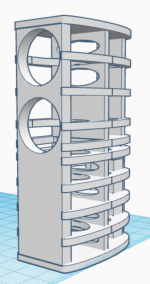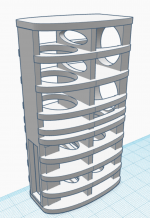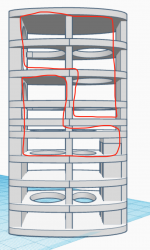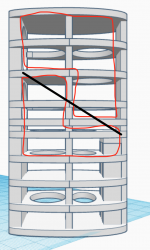So I got a design with both woofers in the top but still with separate chambers in "L" against each other. Though this means the chamber are quite long from the driver to the end of the chamber. Will this cause standing waves to occur again or won't it be that bad?
Attachments
So I got a design with both woofers in the top but still with separate chambers in "L" against each other. Though this means the chamber are quite long from the driver to the end of the chamber. Will this cause standing waves to occur again or won't it be that bad?
That will still give you standing waves, the frequencies shift though. The lower red 'L' is wrong though, either the holes on the bottom have to be closed or (that's what it looks much more likely) you've drawn the 'L' too short and it one brace more to the volume. But then the most distances are the same distance or at least close to each other, which then gives you standing waves on the same frequency in 2 directions. I don't know the measurements and therefore where the standing waves frequencies will be.
You could also build it with tube absorbers. That would solve it too.
Why don't you use an angled board? You don't have to 3d mill/route that one, to be close to it and file off the edge (in front and back) a bit is enough, you can glue that with polyurethane glue, that will close the gap airtight and it's not visible anyway.
Yeah I drew the bottom L wrong.
What do you mean with the angled board? Where and what for?
Standing waves occour at parallel surfaces. Avoiding it being parallel..
Attachments
… curved sides for extra stiffness ...
The reason a curved wall is stiffer is because you are forcing a flat piece of material into a curve. You do not get this with trans-lam construction — it is good for getting unusual shapes, but i think everything else about this approach sucks.
dave
You should lose almost all the horizontal ones, because it is translam in the same orientation, they do very little. I’d brace the drivers to the back of the cabinet (spine-like) and then a couple off to the sides.
Now if you were to skin that frame with a flat-panel you could get the stiffness from forcing a curve, and the bracing would be useful.
These use a similar skeleton, then 3 layers of 6mm rubberply and then 9mm. Vacuum bag and a substantial form to make the curves.
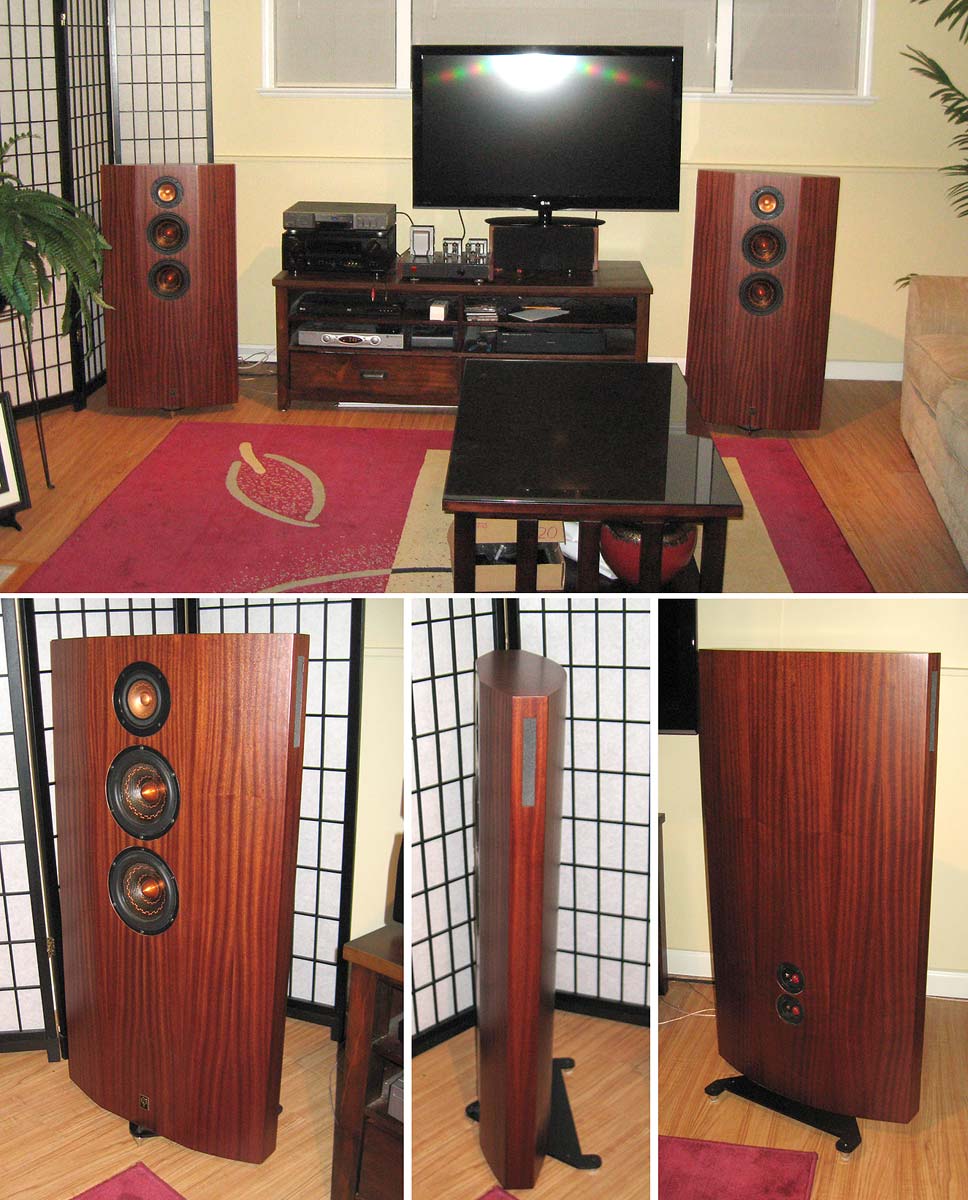
We used the same sides for these (before veneer):
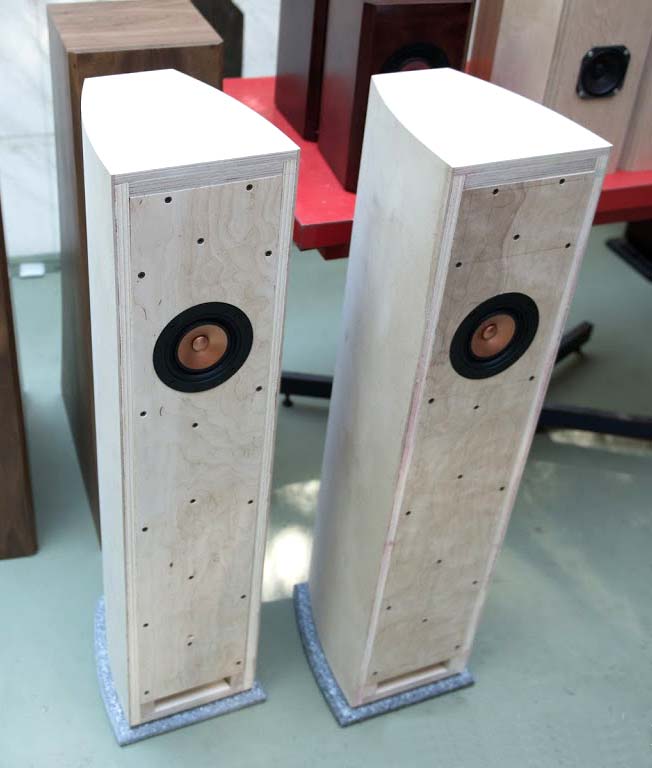
You are showing imaging a bit with tighter radii. Quite doable.
If you want to be over the top this is the way to do it. But a lot more work.
Out there somewhere is a video clip of the large dedicated press used to turn many thin players of wood into a 32mm thick curved plywood shell for the B&W Nautilus 801.
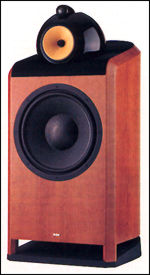
dave
Now if you were to skin that frame with a flat-panel you could get the stiffness from forcing a curve, and the bracing would be useful.
These use a similar skeleton, then 3 layers of 6mm rubberply and then 9mm. Vacuum bag and a substantial form to make the curves.

We used the same sides for these (before veneer):

You are showing imaging a bit with tighter radii. Quite doable.
If you want to be over the top this is the way to do it. But a lot more work.
Out there somewhere is a video clip of the large dedicated press used to turn many thin players of wood into a 32mm thick curved plywood shell for the B&W Nautilus 801.

dave
Out there somewhere is a video clip of the large dedicated press used to turn many thin players of wood into a 32mm thick curved plywood shell for the B&W Nautilus 801.
Found it (1st 20 sec):
YouTube
dave
If you think about it, I think no. A diffuser wouldn't fit into the enclosure to be effective. If you section the enclosure you only make longer paths and standing waves go lower in frequency.
You could dampen the standing waves, use fiberglass wool or similar more expensive healthier product. Also, some other absorbing techniques were mentioned by ICG.
Calculate from box dimensions what the standing wave frequencies are and if they fall into pass band.
With a 300Hz crossover you propably want not to have standing waves under 600Hz, which would mean any dimension longer than ~28cm (half wavelength of 600Hz) have standing waves in pass band.
28cm qube is only ~20 litres, so cannot avoid standing waves in the pass band if your enclosure needs to be larger than this. Just tune them out with damping material
You could dampen the standing waves, use fiberglass wool or similar more expensive healthier product. Also, some other absorbing techniques were mentioned by ICG.
Calculate from box dimensions what the standing wave frequencies are and if they fall into pass band.
With a 300Hz crossover you propably want not to have standing waves under 600Hz, which would mean any dimension longer than ~28cm (half wavelength of 600Hz) have standing waves in pass band.
28cm qube is only ~20 litres, so cannot avoid standing waves in the pass band if your enclosure needs to be larger than this. Just tune them out with damping material
Last edited:
Standing waves don't only happen here. Non-parallel walls are no guarantee of an improvement, or a reduction in modes.Standing waves occour at parallel surfaces. Avoiding it being parallel..
As I said earlier, it's a completely sealed system. I actually have quite some excess volume in the bass cabinets, which I now have cut of with a simple plate.
I've slightly reworked the bracing. Instead of just that skinny beam along the side walls, there is now an entire vertical brac structure which both increases the stiffness in the width and mainly vertical stiffness. The top and bottom are now connected all the by the braces.
I would also like to have both woofers on top for both sonic and aesthetic reasons (the woofers in the middle actually look even worse than I imagined) and I was also thinking about separating the chamber vertically but I'm also afraid that might bring some standing waves back with it because of the length of the chambers.
I'd keep the baffle as uniform as possible. Creating a stepped baffle will time-align in the accoustic domain, but it will also cause lot's of diffraction. Since you are using a Fusion amplifier, I'd recommend time-alligning in the digital domain (by adding delay).
Also for a acoustic diffuser to work well for low frequencies you need depth (I believe it was 1/4th lambda). And you need some distance to let them do their job well. It's not a suitable solution for bass cabinets.
In my opinion the best balance is to keep the cabinet resonances out of the drivers operating range.
I'd also recommend to keep the Q of the bass cabinet below 0.707 if you want good time domain response.
Standing waves don't only happen here. Non-parallel walls are no guarantee of an improvement, or a reduction in modes.
Standing waves occurs if they are reflected and travel the same way back, therefore the name standing waves, they do not move. A standing wave can also be diverted or follow bends (TML). With non-parallel walls it is in most cases not possible to initiate a standing wave though because it can't travel the same way back and add in amplitude.
...and amount of damping and it seriously makes the entire speaker.
+1tune them out with damping material
So then as I already knew the curved walls should already prevent a big part of the standing waves. Really the only thing to be dealt with is the vertical standing wave in the height of the enclosure. If standing waves are (mostly) caused by parallel surfaces, won't it just be possible to prevent the vertical standing wave by making the internal bottom and/or top wall slanted? This would be fairly easy to implement, let alone compared to splitting the cabinet in two without creating more parallel surfaces.
I am and will be handling time alignment in the DSP. As I said before, the bass, midrange and tweeter modules are separated purely for vibration decoupling and being able to swap drivers without having to rebuild the entire cabinets would I want to switch for example to the beryllium Illuminator in the future. They are not for time alignment.
Why should the Qtc be 0,707 or lower? Then the woofers will reach Xmax rather quickly. And it doesn't make that much of a difference in impulse response. In fact, in a smaller enclosure, the the first recoil is shorter though at the cost of a tiny bit more stretched out wobbling after that.
@40 W:
I am and will be handling time alignment in the DSP. As I said before, the bass, midrange and tweeter modules are separated purely for vibration decoupling and being able to swap drivers without having to rebuild the entire cabinets would I want to switch for example to the beryllium Illuminator in the future. They are not for time alignment.
Why should the Qtc be 0,707 or lower? Then the woofers will reach Xmax rather quickly. And it doesn't make that much of a difference in impulse response. In fact, in a smaller enclosure, the the first recoil is shorter though at the cost of a tiny bit more stretched out wobbling after that.
@40 W:
Attachments
-
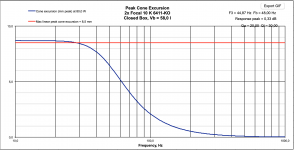 Schermafbeelding 2019-05-16 om 16.55.43.png118.1 KB · Views: 97
Schermafbeelding 2019-05-16 om 16.55.43.png118.1 KB · Views: 97 -
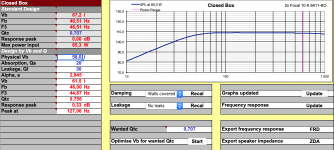 Schermafbeelding 2019-05-16 om 16.55.32.png203.8 KB · Views: 91
Schermafbeelding 2019-05-16 om 16.55.32.png203.8 KB · Views: 91 -
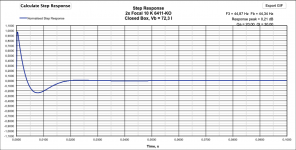 Schermafbeelding 2019-05-16 om 16.55.02.png204.9 KB · Views: 99
Schermafbeelding 2019-05-16 om 16.55.02.png204.9 KB · Views: 99 -
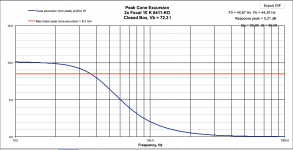 Schermafbeelding 2019-05-16 om 16.55.10.png114.4 KB · Views: 97
Schermafbeelding 2019-05-16 om 16.55.10.png114.4 KB · Views: 97 -
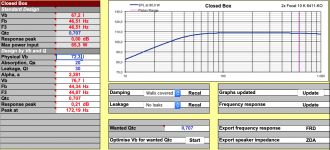 Schermafbeelding 2019-05-16 om 16.54.41.png224.2 KB · Views: 103
Schermafbeelding 2019-05-16 om 16.54.41.png224.2 KB · Views: 103 -
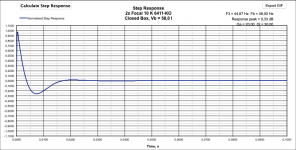 Schermafbeelding 2019-05-16 om 16.55.54.png205.5 KB · Views: 29
Schermafbeelding 2019-05-16 om 16.55.54.png205.5 KB · Views: 29
- Status
- This old topic is closed. If you want to reopen this topic, contact a moderator using the "Report Post" button.
- Home
- Loudspeakers
- Multi-Way
- Redesigning my cabinets. Thoughts?
